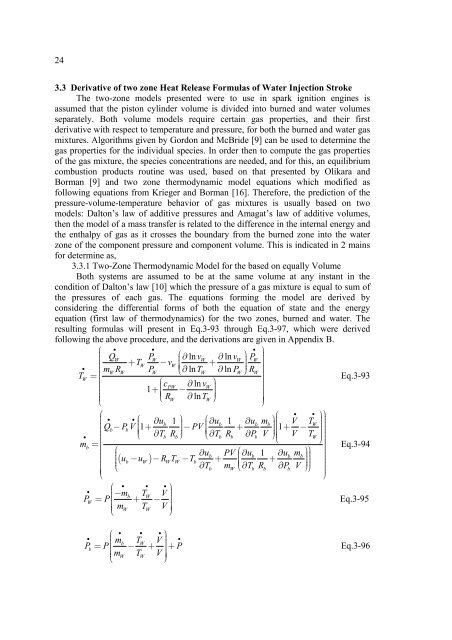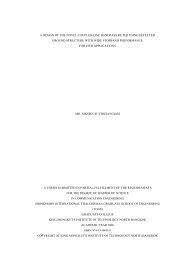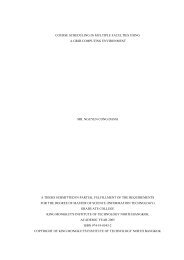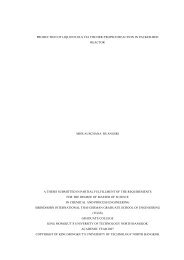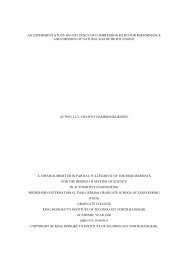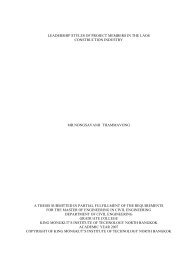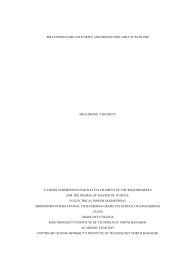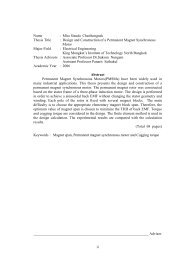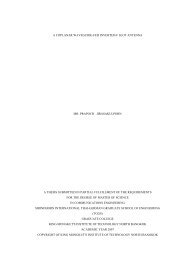23[ A][ ∂y/ ∂ P] + [ ∂f / ∂ P] = 0. The matrix [ A ] is seen to be identical to that used earlierin the Newton iteration from Eq.3-62 through Eq.3-65. To evaluate ∂f/ ∂ P , whichdefined by inspection <strong>of</strong> Eq.3-48 through Eq.3-54 reveals that x iare functions<strong>of</strong> y by i= 3, 4,5 and 6. S0,ix = y / c , x = y / c , x = y / c , x = y / c , x = y / c , x = y / c71 1 1 2 2 2 7 7 4 8 8 5 9 9 3 10 10and x11 = y11 / c8Substitution <strong>of</strong> x i<strong>into</strong> Eq.3-37 through Eq.3-40 followed by differentiation withrespect to P , Eq.3-37 expressed as below,y7 c5 y8 c3 y9 c7 y10 c611∂f1 ∂c1 ∂y1 ∂c2 ∂y2 ∂c ∂ ∂ ∂ ∂ ∂ ∂ ∂ ∂4∂y= + + + + + +∂P ∂P ∂c ∂P ∂c ∂P ∂c ∂P ∂c ∂P ∂c ∂P ∂c ∂P ∂c1 2 7 5 3 76Eq.3-88Where, ∂y / ∂ c = y / c , ∂y / ∂ c = y / c , ∂y / ∂ c = y / c , ∂y / ∂ c = y / c ,1 1 1 1 2 2 2 2 7 7 7 7 8 5 8 5∂y9 / ∂ c3 = y9 / c3, ∂y10 / ∂ c7 = y10 / c7 and ∂y11 / ∂ c6 = y11 / c6.Also, differentiationwith respect to P expressed from Eq.3-37 through Eq.3-40 as below,∂f ∂c ∂c ∂c∂ c ∂ c ∂ c ∂ c∂ ∂ ∂ ∂ ∂ ∂ ∂ ∂1 1 2 45 3 7 6= x1+ x2 + x7 + x8 + x9 + x10+11P P P P P P P P x∂f ∂c ∂c ∂ c ∂c∂ ∂ ∂ ∂ ∂2 2 4 31= 2 x2 + x7 + x9 −d11P P P P P x∂ f3 ∂c1 ∂c2 c5 c3 c7c12 x1 x ∂ 2x ∂ 8x ∂ ∂= + + +9+ x10 −d2x∂P ∂P ∂P ∂P ∂P ∂P ∂P∂f4∂c ∂c ∂c1= x + x −d x∂P ∂P ∂P ∂P7 610 11 3 11Eq.3-89Eq.3-90Eq.3-91Eq.3-92From the expressions forc and derivatives c as below:i1/2 1/2 1/2 1/2 1/2c = P / K , c = K P , c = K , c = K / P , c = K / P , c = K / P , c = K∂c1 1 1 c1 ∂c2 1 K2 1 c2 ∂c3∂c4 1 K4 1 c4= = , = = , = 0, =− =−1/2 1/2 3/2∂P 2P K 2 P ∂P 2 P 2 P ∂P ∂P 2 P 2 P1 1 2 2 3 3 4 4 5 5 6 6 7 71∂c5 1 K5 1 c5 ∂c6 1 K6 1 c6 ∂c7=− =− , =− =− , = 03/2 3/2∂P 2 P 2 P ∂P 2 P 2 P ∂Pand dKi/ dP = 0The above results define the basic <strong>of</strong> rates <strong>of</strong> change <strong>of</strong> species concentrationwith respect to <strong>temperature</strong> ( ∂yi/ ∂ T)and pressure( ∂yi/ ∂ P)for i = 1,....,11,whichcan be solved <strong>into</strong> section 3.1.1 and 3.1.5.i
243.3 Derivative <strong>of</strong> two zone Heat Release Formulas <strong>of</strong> Water Injection StrokeThe two-zone models presented were to use in spark ignition engines isassumed that the piston cylinder volume is divided <strong>into</strong> burned and <strong>water</strong> volumesseparately. Both volume models require certain gas properties, and their firstderivative with respect to <strong>temperature</strong> and pressure, for both the burned and <strong>water</strong> gas<strong>mixture</strong>s. Algorithms given by Gordon and McBride [9] can be used to determine thegas properties for the individual species. In order then to compute the gas properties<strong>of</strong> the gas <strong>mixture</strong>, the species concentrations are needed, and for this, an equilibriumcombustion products routine was used, based on that presented by Olikara andBorman [9] and two zone thermodynamic model equations which modified asfollowing equations from Krieger and Borman [16]. Therefore, the prediction <strong>of</strong> thepressure-volume-<strong>temperature</strong> behavior <strong>of</strong> gas <strong>mixture</strong>s is usually based on twomodels: Dalton’s law <strong>of</strong> additive pressures and Amagat’s law <strong>of</strong> additive volumes,then the model <strong>of</strong> a mass transfer is related to the difference in the internal energy andthe enthalpy <strong>of</strong> gas as it crosses the boundary from the burned zone <strong>into</strong> the <strong>water</strong>zone <strong>of</strong> the component pressure and component volume. This is indicated in 2 mainsfor determine as,3.3.1 Two-Zone Thermodynamic Model for the based on equally VolumeBoth systems are assumed to be at the same volume at any instant in thecondition <strong>of</strong> Dalton’s law [10] which the pressure <strong>of</strong> a gas <strong>mixture</strong> is equal to sum <strong>of</strong>the pressures <strong>of</strong> each gas. The equations forming the model are derived byconsidering the differential forms <strong>of</strong> both the equation <strong>of</strong> state and the energyequation (first law <strong>of</strong> thermodynamics) for the two zones, burned and <strong>water</strong>. Theresulting formulas will present in Eq.3-93 through Eq.3-97, which were derivedfollowing the above procedure, and the derivations are given in Appendix B.⎛• ••⎛ ln ln ⎞⎞Q WPW ∂ vW ∂ vW+ − +P •TWvWW⎜∂⎜ ln ∂ln⎟m ⎝= WRW PW TW PW ⎠RWTWEq.3-93⎛ ∂ ln ⎞1+ cPWvW−⎜⎜ ∂ ln⎝ R ⎟⎠ ⎜⎝WTW⎟⎠⎛• • ⎞• • ⎛ 1 ⎞ ⎛ 1 ⎞⎛ ⎞ ∂ub ⎜1 ∂ub ∂ub mb⎟⎜V T − + − + 1+ −QbPbV ⎜PVW⎟⎜⎟•⎝ ∂Tb Rb⎠ ⎝∂Tb Rb ∂Pb V ⎠⎜⎜V T⎝W ⎟m = b⎛ ∂ ⎛∂ Eq.3-941 ∂ ⎞⎞ub PV( − ) − − + ub ub mb+u buW RWTW T⎠⎟b⎜⎝∂ ⎜T ⎝⎜∂ ∂ ⎠⎟⎟⎠b mW Tb Rb Pb V⎜⎝⎟⎠⎛ • • • ⎞•−mbTWVPW= P + −Eq.3-95⎜ mW TW V⎜⎝⎟⎠⎛• • •• mbTWV•Pb= P − + + P⎜mWTWV⎟⎜⎝⎞ ⎟⎟⎠Eq.3-96
- Page 1 and 2: ANALYSIS OF WATER INJECTION INTO HI
- Page 3 and 4: Thesis CertificateThe Graduate Coll
- Page 5 and 6: ชื่อ : นายปรม
- Page 7 and 8: TABLE OF CONTENTSPageAbstract (in E
- Page 9 and 10: LIST OF TABLESTablePage3-1 Solution
- Page 11 and 12: LIST OF FIGURES (CONTINUED)FigurePa
- Page 13 and 14: LIST OF ABBREVIATIONS, SYMBOLS AND
- Page 15 and 16: CHAPTER 1INTRODUCTION1.1 Background
- Page 17 and 18: 31.6.6 Water injected is assumed to
- Page 19 and 20: 6for these working fluid models can
- Page 22 and 23: CHAPTER 3METHODOLOGY FOR ANALYSIS O
- Page 24 and 25: 11perform the necessary calculation
- Page 26 and 27: 13h b P T w−0.2 0.8 −0.55 0.8=
- Page 28 and 29: 15the procedure required Nitrogen(
- Page 30 and 31: 171N22 NEq.3-461 1O+2N2 NOEq.3-472
- Page 32 and 33: 19∂y1 cy ∂y1 cy ∂y 1 c ∂y 1
- Page 34 and 35: 211/2( cy )∂y ∂∂c ∂y∂T
- Page 38 and 39: 25⎛ • • •ln ln ⎞⎛⎞( )
- Page 40 and 41: 27( θ= −π)θ>θ bθ>θ W( θ=π
- Page 42 and 43: CHAPTER 4RESULTS AND DISCUSSIONThis
- Page 44 and 45: 31FIGURE 4-1 Comparison of an actua
- Page 46 and 47: 33FIGURE 4-4 Schematic of the port
- Page 48 and 49: 35Temperature (K)250023002100190017
- Page 50 and 51: 37cylinder temperature. So, a more
- Page 52 and 53: 39Thermal efficiency (%)43424140393
- Page 54 and 55: 41Theoretically, the high useful co
- Page 56 and 57: 43Thermal efficiency (%)46454443424
- Page 58 and 59: 45injection-fuel ratio increases gr
- Page 60 and 61: 47Thermal efficiency (%)44434241403
- Page 62 and 63: 49When considering relative tempera
- Page 64 and 65: 51Temperature (K)240021001800150012
- Page 66 and 67: 53When considering relative tempera
- Page 68 and 69: 55Temperature (K)220019001600130010
- Page 70 and 71: CHAPTER 5CONCLUSIONS AND SUGGESTION
- Page 72 and 73: REFERENCES1. Ricardo, H.R. The High
- Page 74: APPENDIX ADerivative equations of i
- Page 78 and 79: 64TABLE A-3 Curve fit coefficients
- Page 80 and 81: 66TABLE A-5 Curve fit coefficients
- Page 82 and 83: 68The following is the derivative v
- Page 84 and 85: 70From the definition of entropyh =
- Page 86 and 87:
72• ⎛ ⎞ • ⎛Tb∂u •b∂
- Page 88 and 89:
74• ⎛1 ⎞ •∂u ⎛∂ ∂
- Page 90 and 91:
76⎛ • • •ln ln ⎞⎛⎞( )
- Page 92 and 93:
78The following is the derivative v
- Page 94 and 95:
80From the definition of entropy h
- Page 96 and 97:
82• ⎛ Tb u ⎞ • • ⎛bmTb
- Page 98 and 99:
84• ⎛1 ⎞ • •∂u ⎛ ⎞
- Page 100 and 101:
86• • • ⎛ u ⎞bmb( hW ub)
- Page 102 and 103:
88Appendix D MATLAB program scripts
- Page 104 and 105:
90[thetawater,pTbWQlHl2]=ode45('Rat
- Page 106 and 107:
92-0.69353550E-14 -0.14245228E+05 0
- Page 108 and 109:
940.21*(1-phi) 0 0]';dcdT=0;else %
- Page 110 and 111:
96dfdp=zeros(4,1);dYdT=zeros(11,1);
- Page 112 and 113:
98dcdT(1)=-dKdT(1)*sqrt(patm)/K(1)^
- Page 114 and 115:
100Iter=Iter+1;[hb,u,v,s,Y,cp,dlvlT
- Page 116 and 117:
102yprime(2)=-Const1/cpb/x*Qconvb+v
- Page 118 and 119:
104masswaterin=massfuel*mwpmf;% Tot
- Page 120 and 121:
106savefile = 'Volume.mat';RTWV=RTW
- Page 122 and 123:
108p=pTarray(:,1);T=pTarray(:,2);hc
- Page 124 and 125:
110gamma_der_tautau = 0;for i = 1 :


